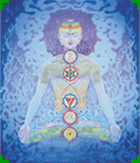|
|
|
 |
Chakras
|
 |
Chakra is a Sanskrit word meaning wheel or vortex and it refers to each of the seven energy centers of which our consciousness and our energy system is composed. These chakras, or energy centers, function as pumps or valves, regulating the flow of energy through our energy system. The functioning of the chakras reflects decisions we make concerning how we choose to respond to conditions in our life. We open and close these valves when we decide what to think, and what to feel, and through which perceptual filter we choose to experience the world around us.
The chakras are not physical. They are aspects of consciousness in the same way that the auras are aspects of consciousness. The chakras are more dense than the auras, but not as dense as the physical body. They interact with the physical body through two major vehicles, the endocrine system and the nervous system. Each of the seven chakras is associated with one of the seven endocrine glands, and also with a group of nerves called a plexus. |
Thus, each chakra can be associated with particular parts of the body and particular functions within the body controlled by that plexus or that endocrine gland associated with that chakra. |
| |
All of your senses, all of your perceptions, all of your possible states of awareness, everything that is possible for you to experience, can be divided into seven categories. Each category can be associated with a particular chakra. Thus, the chakras represent not only particular parts of your physical body, but also particular parts of your consciousness.
When you feel tension in your consciousness, you feel it in the chakra associated with that part of your consciousness experiencing the stress, and in the parts of the physical body associated with that chakra. Where you feel the stress depends upon why you feel the stress. The tension in the chakra is detected by the nerves of the plexus associated with that chakra, and transmitted to the parts of the body controlled by that plexus. When the tension continues over a period of time, or to a particular level of intensity, the person creates a symptom on the physical level. |
|
Panditji sums it all by remarking that understanding the chakras allows you to understand the relationship between your consciousness and your body, and to thus see your body as a map of your consciousness. It gives you a better understanding of yourself and those around you.
---------------------------------------------------------------------------------------------------------------------------------------------------------- |
|
:: Sahasrara Chakra
Thought, Universal identity, oriented to self-knowledge
This is the crown chakra that relates to consciousness as pure awareness. It is our connection to the greater world beyond, to a timeless, spaceless place of all-knowing. When developed, this chakra brings us knowledge, wisdom, understanding, spiritual connection, and bliss. |
|
:: Ajna Chakra
Light, Archetypal identity, oriented to self-reflection
This chakra is known as the brow chakra or third eye center. It is related to the act of seeing, both physically and intuitively. As such it opens our psychic faculties and our understanding of archetypal levels. When healthy it allows us to see clearly, in effect, letting us "see the big picture." |
|
:: Vishuddha Chakra
Sound, Creative identity, oriented to self-expression
This is the chakra located in the throat and is thus related to communication and creativity. Here we experience the world symbolically through vibration, such as the vibration of sound representing language. |
|
:: Anahata Chakra
Air, Social identity, oriented to self-acceptance
This chakra is called the heart chakra and is the middle chakra in a system of seven. It is related to love and is the integrator of opposites in the psyche: mind and body, male and female, persona and shadow, ego and unity. A healthy fourth chakra allows us to love deeply, feel compassion, have a deep sense of peace and centeredness |
|
:: Manipura Chakra
Fire, Ego identity, oriented to self-definition
This chakra is known as the power chakra, located in the solar plexus. It rules our personal power, will, and autonomy, as well as our metabolism. When healthy, this chakra brings us energy, effectiveness, spontaneity, and non-dominating power.
|
|
:: Svadhishthana Chakra
Water, Emotional identity, oriented to self-gratification
The second chakra, located in the abdomen, lower back, and sexual organs, is related to the element water, and to emotions and sexuality. It connects us to others through feeling, desire, sensation, and movement. Ideally this chakra brings us fluidity and grace, depth of feeling, sexual fulfillment, and the ability to accept change. |
|
:: Muladhara Chakra
Earth, Physical identity, oriented to self-preservation
Located at the base of the spine, this chakra forms our foundation. It represents the element earth, and is therefore related to our survival instincts, and to our sense of grounding and connection to our bodies and the physical plane. Ideally this chakra brings us health, prosperity, security, and dynamic presence. |
|
|
|
|
|
|
|
|
|